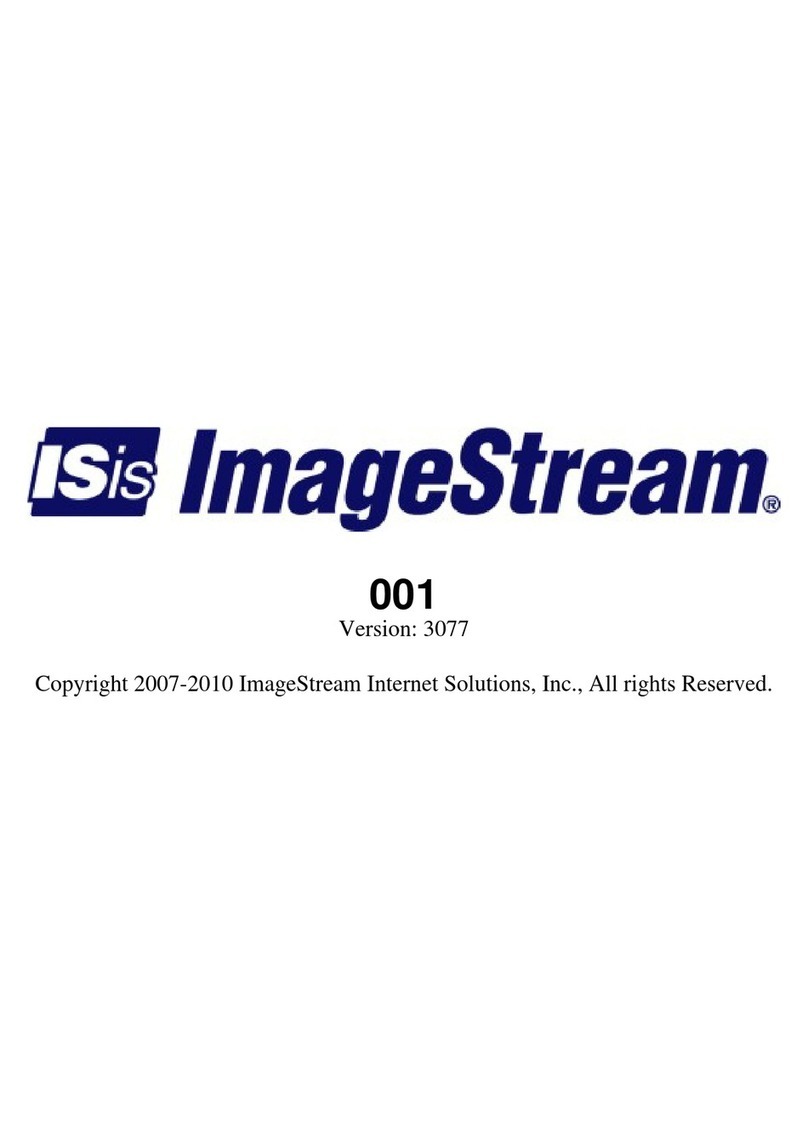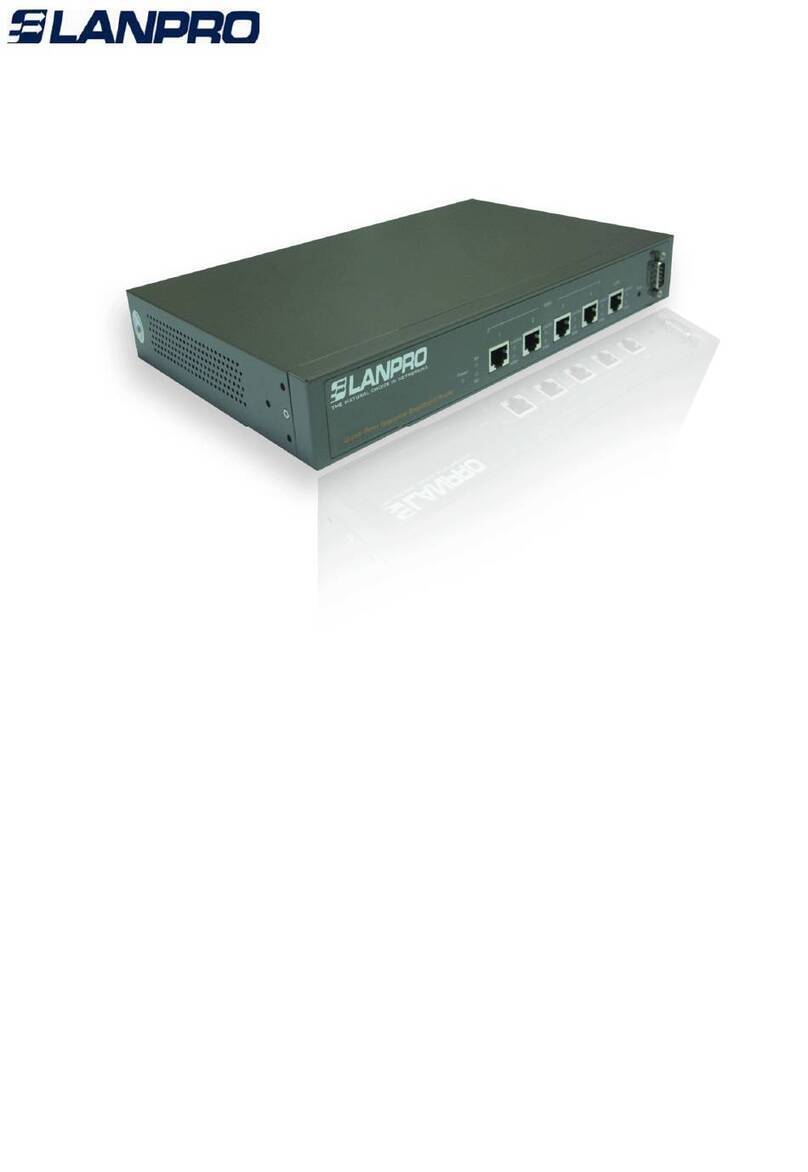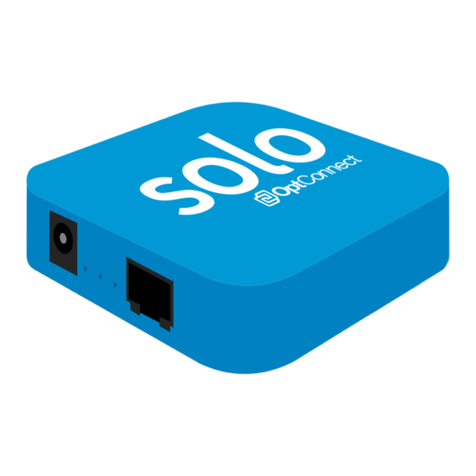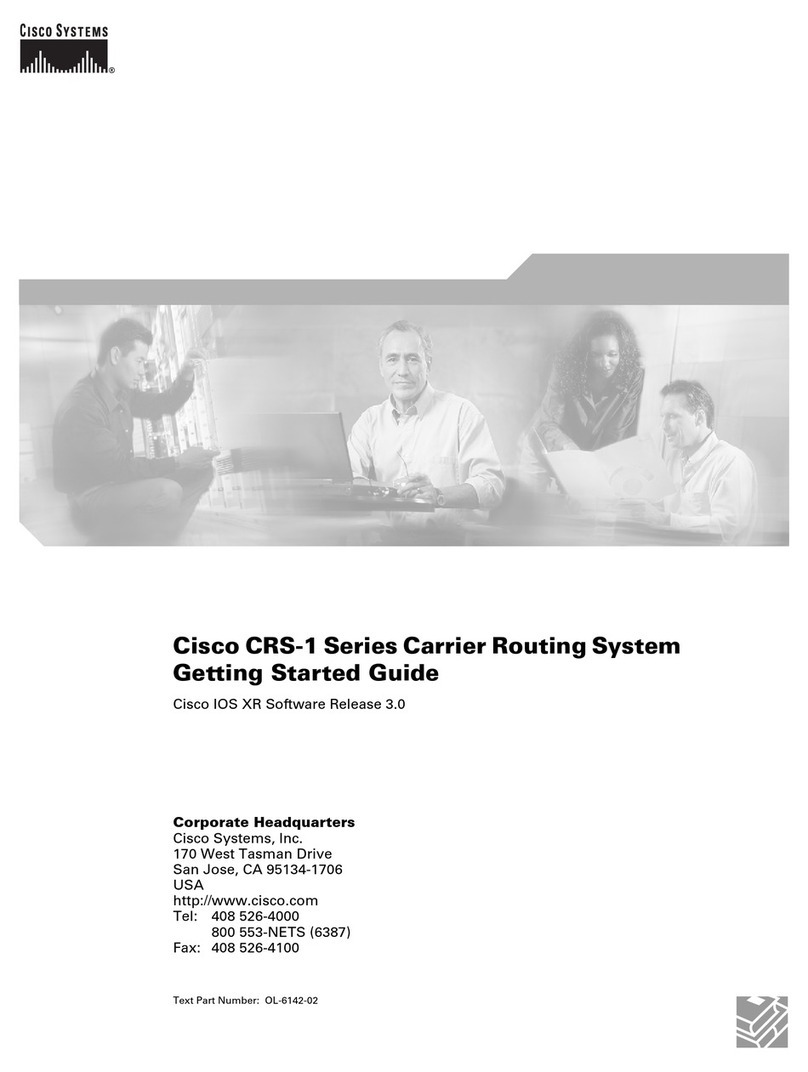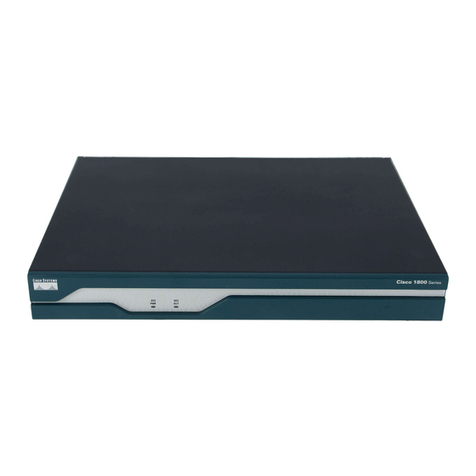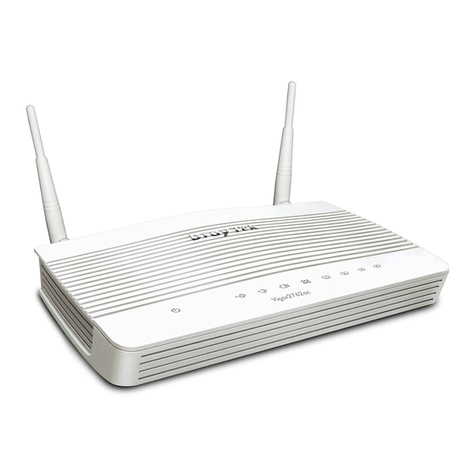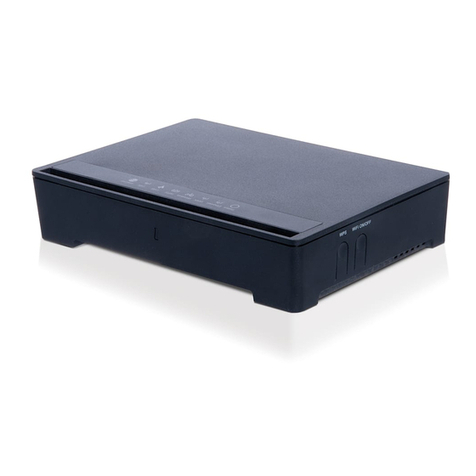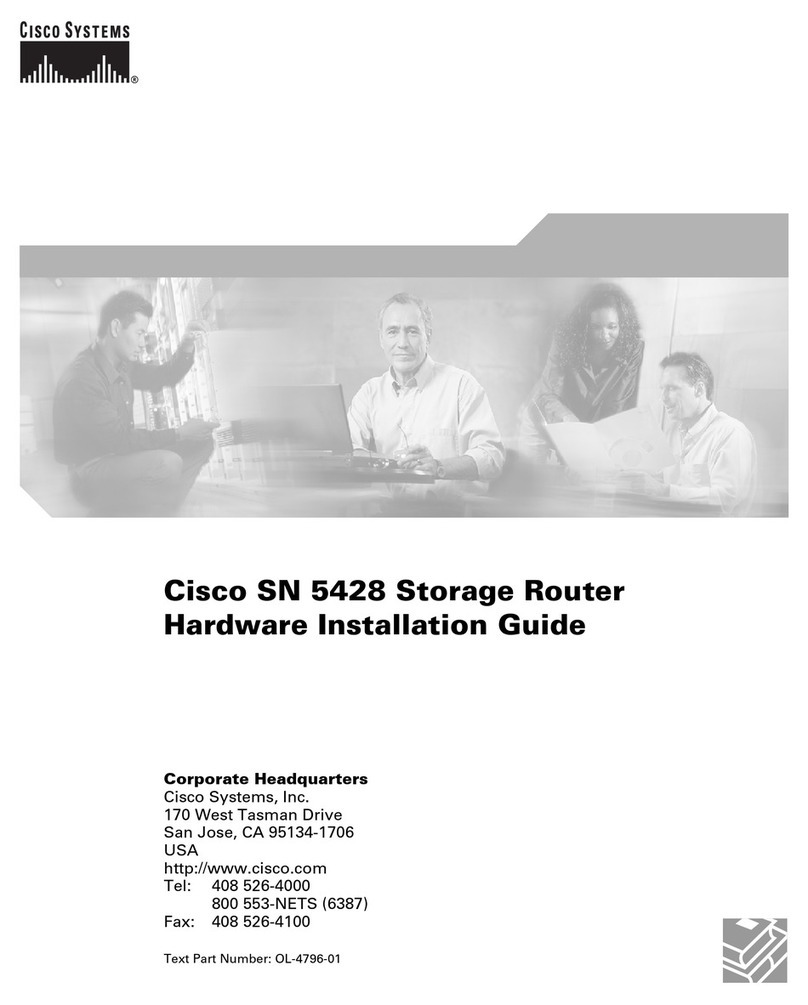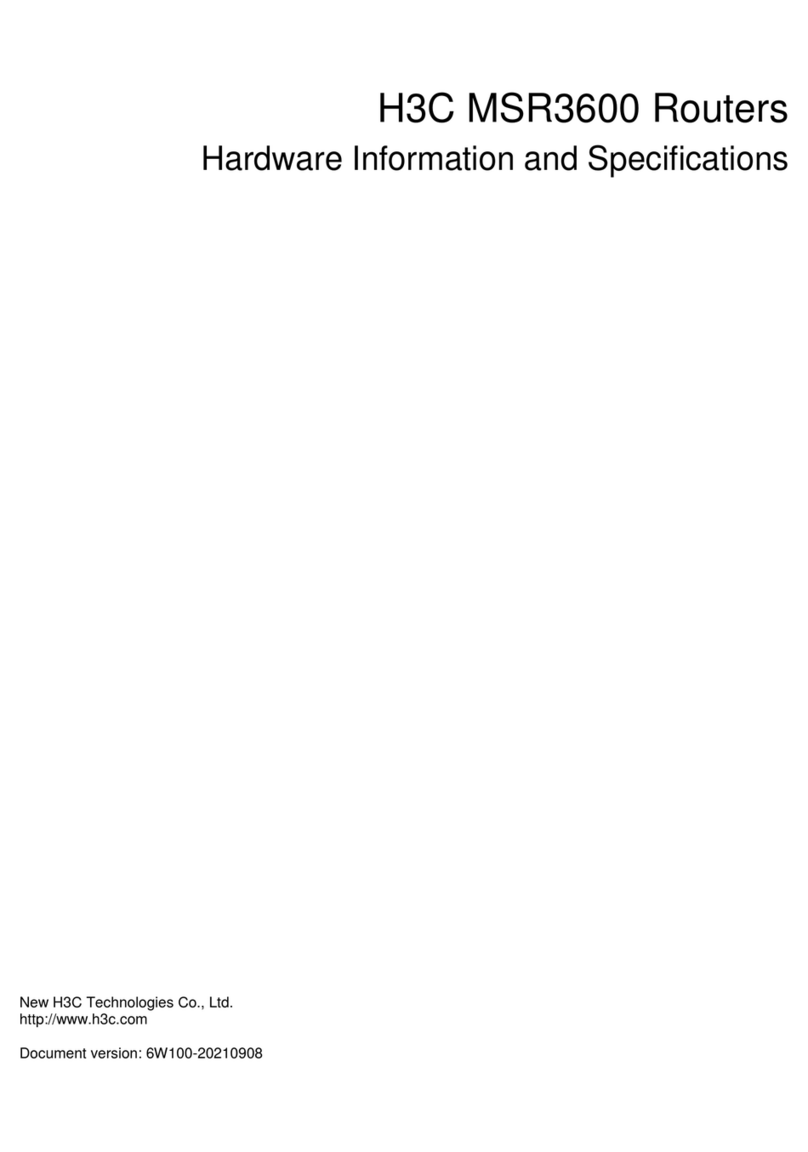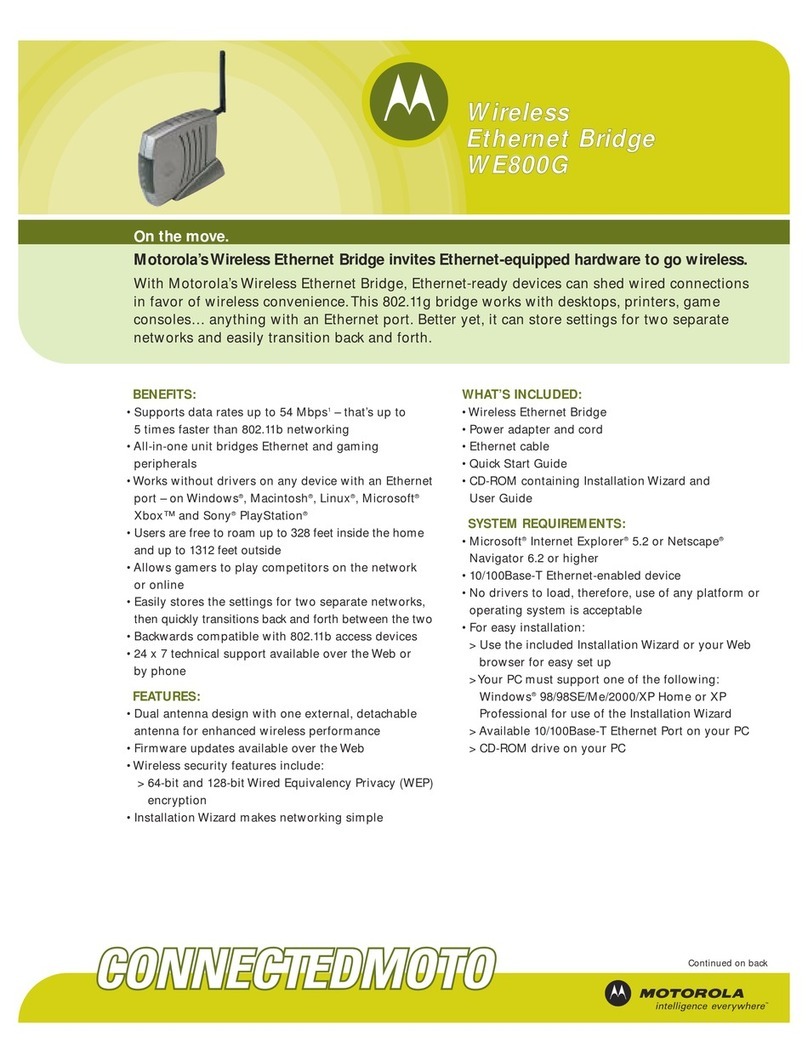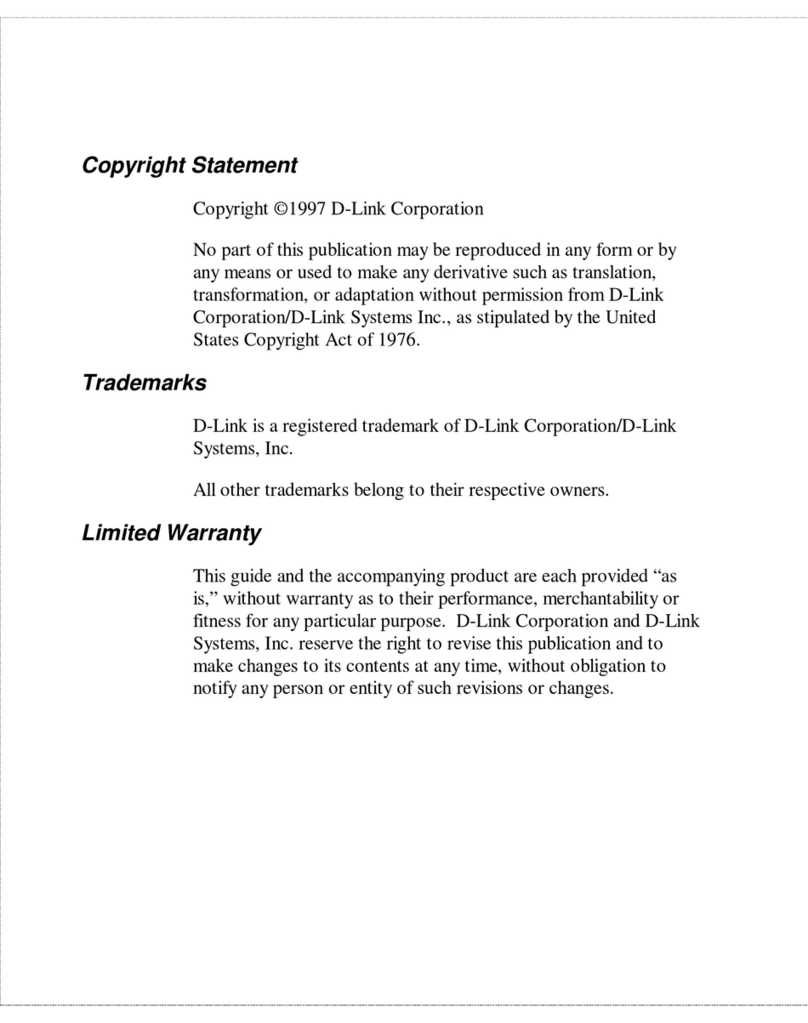General DataComm SpectraComm IP T1 User manual

The Best Connections in the Business
General DataComm
6SHFWUD&RPP#,3#
T1 ROUTER CARD
Installation & Operation Manual
076R200-000
Issue 13
October 2013

Copyright
©2013 General DataComm, Inc. ALL RIGHTS RESERVED.
This publication and the software it describes contain proprietary and confidential information. No part of this
document may becopied, photocopied, reproduced, translated or reduced to any electronic or machine-readable
format without prior written permission of General DataComm,Inc. The information in this document is subject
to change without notice. General DataComm assumes no responsibility for any damages arising from the use
of this document, including but not limited to, lost revenue, lost data, claims by third parties, or other damages.
If you have comments or suggestions concerning this manual, please contact:
General DataComm, Inc.
Technical Publications
6 Rubber Avenue, Naugatuck, Connecticut USA 06770 Telephone: 1 203 729 0271
Trademarks
All brand or product names are trademarks or registered trademarks of their respective companies or
organizations.
Documentation
Revision History - GDC P/N 076R200-000
Related Publications
-REV is the hardware revision (-000,-001, etc.)
-VREF is the most current software version (-V400 is Version 4.0.0.)
In addition to the publications listed above, always read the release notes for your products.
Issue Date Description of Change
1 April 2002 Initial Feature Set Documentation.
2 October 2002 Supports Spanning Tree Protocol.
Corrected and additional cable and pinout information.
3 March 2003 Supports integral V.90 modem, S1 interface (to SC 521A CSU),
S0 interface, T1 diagnostics/statistics, and spanning tree protocol
4 May 2003 Supports TACACS+ Authentication, T1 Diagnostics, Contact Sense, SNMP Traps;
Provides logging features, Telnet menu.
5 September 2003 Supports MACL Security and additional TACACS+ Authentication features.
6 November 2004 Revised configuration procedures; minor corrections.
7 April 2006 Additional SNMP traps, LAN-X features, modem security features.
8 September 2009 Added cable information for the Contact Sense interface; minor updates/clarifications
9 May 2010 Added Secure Shell (SSH) access, clarified Telnet/Terminal interface, minor updates
10 February 2011 Added 12VDC standalone enclosure; Clarifies Ethernet (LAN) port performance.
11 June 2011 Corrected pinout information.
12 May 2012 Minor updates/enclosure branding
13 October 2013 Minor updates, clatifications
Description Part Number
SpectraComm 5000/UAS Shelf Installation and Operation Manual 010R302-REV
SpectraComm 2000 Shelf Installation and Operation Manual 010R358-REV
SpectraComm Standalone Enclosures Installation and Operation Manual 010R112-REV
SpectraComm Ethernet Switch Card Installation & Operation Manual 076R204-REV
Operation Manuals other SpectraComm IP devices Refer to GDC Publicatons
CD or go to www.gdc.com.
Operation Manuals for SCM-compatible elements

076R200-000 SpectraComm IP T1 Router Card i
Issue 13 Installation and Operation Manual
Table of Contents
Preface
Precautions .........................................................................................................................vi
Compliance ............................................................................................................................. vii
Support Services and Training................................................................................................. ix
Corporate Client Services...................................................................................................ix
Factory Direct Support & Repair .......................................................................................ix
Contact Information ...........................................................................................................ix
Chapter 1: Introduction and Specifications
SpectraComm IP Overview ................................................................................................... 1-1
Features and Benefits .......................................................................................................1-2
SCIP Interfaces/Connectivity...........................................................................................1-3
Shelf / Enclosure Options.................................................................................................1-4
Management.....................................................................................................................1-5
Diagnostic Tests ...............................................................................................................1-6
Diagnostic Tools...............................................................................................................1-6
Alarms ..............................................................................................................................1-6
SNMP Traps.....................................................................................................................1-6
SCIP Router Applications ................................................................................................1-7
SCIP LAN-X Applications...............................................................................................1-8
SCIP with Spanning Tree.................................................................................................1-9
Contact Sense Applications............................................................................................1-10
Security & Access Features ................................................................................................. 1-11
Secure Shell (SSH) Protocol ..........................................................................................1-11
SCIP with MACL Security.............................................................................................1-11
SCIP Applications with Ethernet Switching ..................................................................1-13
The SCIP Front Panel .......................................................................................................... 1-14
Technical Specifications ...................................................................................................... 1-15
Chapter 2: Installation & Connections
Overview................................................................................................................................ 2-1
Unpacking Instructions.....................................................................................................2-2
SCIP Equipment...............................................................................................................2-2
Shelf System Options.......................................................................................................2-3
Shelf and Card Connections................................................................................................... 2-4
Network / Modem Port.....................................................................................................2-5
Sync/Async Port...............................................................................................................2-6
Contact Sense Port............................................................................................................2-7
Terminal Server Port ......................................................................................................2-10
Craft Port (DCE Interface) .............................................................................................2-14

ii SpectraComm IP T1 Router Card 076R200-000
Installation and Operation Manual Issue 13
Table of Contents
Ethernet (LAN) Ports.....................................................................................................2-14
SCIP Power-Up ................................................................................................................... 2-15
Modem Connectivity........................................................................................................... 2-16
SCIP Modem Configuration ..........................................................................................2-16
Modem Procedures ........................................................................................................2-16
Chapter 3: SCIP Configuration
SCIP Configuration Overview............................................................................................... 3-1
Smart CLI Quick Reference............................................................................................. 3-1
Initializing the SCIP .............................................................................................................. 3-2
Configure the Craft Port................................................................................................... 3-2
Configure Remote Communication................................................................................. 3-3
Configuring CLI User Privileges..................................................................................... 3-4
Configuring Management................................................................................................ 3-5
Configuring Typical SCIP Networks .................................................................................... 3-8
Static Routing with Frame Relay over a T1 Network...................................................... 3-8
Static Routing with PPP over a T1 Network..................................................................3-12
LAN-Extension over T1 for a Flat Networks ................................................................3-15
Terminal Server Management............................................................................................. 3-19
Setting Up SCIP.............................................................................................................3-19
CLI Command Access...................................................................................................3-20
Telnet/SSH Menu Cut-thru............................................................................................3-21
Telnet/SSH Port Cut-Thru .............................................................................................3-22
Telnet/SSH IP Cut-thru..................................................................................................3-23
Chapter 4: The Web Interface
Introduction to SCIP Web Management ............................................................................... 4-1
Web Management Requirements..................................................................................... 4-1
Starting A Web Session................................................................................................... 4-2
Command Line Web Screen............................................................................................ 4-3
Chapter 5: Additional Features
Overview of Additional Features .......................................................................................... 5-1
Time Protocols....................................................................................................................... 5-1
TACACS+ Authentication Protocol...................................................................................... 5-2
Modem Security .................................................................................................................... 5-6
Media Access Control (MAC) Security ............................................................................... 5-7
Contact Sense ...................................................................................................................... 5-11
LAN-X Traffic Control Features......................................................................................... 5-13
Ethernet Broadcast Limiting..........................................................................................5-13

076R200-000 SpectraComm IP T1 Router Card iii
Issue 13 Installation and Operation Manual
Table of Contents
Ethernet Jumbo (Extended) Packets...............................................................................5-13
Expedited Traffic Queuing.............................................................................................5-14
Spanning Tree Protocol..................................................................................................5-16
Chapter 6: Diagnostics & Monitoring
Diagnostics Overview............................................................................................................ 6-1
T1 Diagnostic Tests..........................................................................................................6-2
Traceroute.........................................................................................................................6-4
LAN-X Link Integrity Check...........................................................................................6-5
LAN-X Utilities................................................................................................................6-6
Monitoring Features............................................................................................................... 6-7
SNMP Traps.....................................................................................................................6-7
System Message Log........................................................................................................6-8
Alarm Log ........................................................................................................................6-8
MACL Violation Log.......................................................................................................6-9
Network Statistics...........................................................................................................6-10
Modem Activity Log......................................................................................................6-10
Appendix A:Application Guidelines
General Application Information.......................................................................................... A-1
Command Access Modes...................................................................................................... A-1
SCIP Default Configurations................................................................................................ A-2
Using Sub-interfaces for Frame Relay PVCs ....................................................................... A-7
IP Addresses.......................................................................................................................... A-7
Establishing an IP Address..............................................................................................A-9
Bridging/Routing Guidelines................................................................................................ A-9
S0 and S1 Comparison........................................................................................................ A-10
Ones Density Enforcement ................................................................................................. A-11
Batch Up/Download Overview........................................................................................... A-12
Using Smart CLI................................................................................................................. A-13
Troubleshooting Communications Problems...................................................................... A-16

iv SpectraComm IP T1 Router Card 076R200-000
Installation and Operation Manual Issue 13
Table of Contents

076R200-000 SpectraComm IP T1 Router Card v
Issue 13 Installation and Operation Manual
Preface
Scope of this Manual
This manual describes installation and operation of the SpectraComm IP card (SC-IP). This
document is intended for network operators and installers and assumes a working knowledge of
data communication equipment.
The information in this manual has been carefully checked and is believed to be entirely reliable.
However, as General DataComm improves the reliability, function and design of its products, it is
possible that information may not be current. Check the General DataComm website at
http://www.gdc.com for updated manuals and product information, or contact your General
DataComm field representative.
General DataComm, Inc.
6 Rubber Avenue
Naugatuck, Connecticut, USA 06770
Tel: 1 203 729-0271
Safety Information
This manual should be read in its entirety and all procedures completely understood before
installing or operating the unit. The notes that appear throughout this manual must be read prior to
any installation or operating procedure. Examples of notes used in this manual are shown below.
Note A note provides essential operating information not readily apparent which you should be
particularly aware of. A note is typically used as a suggestion.
Important Indicates an emphasized note. It is something you should be particularly aware of; something
not readily apparent. Important is typically used to prevent equipment damage.

Preface
vi SpectraComm IP T1 Router Card 076R200-000
Installation and Operation Manual Issue 13
Precautions
The CAUTION, WARNING, and DANGER statements that appear throughout this manual are
intended to provide critical information for the safety of both the service engineer and operator, and
enhance equipment reliability. The definitions and symbols for such statements comply with ANSI
Z535.2, American National Standard for Environmental and Facility Safety Signs, and ANSI
Z535.4, Product Safety Signs and Labels, issued by the American National Standards Institute.
Safety Guidelines
Under proper conditions, this unit will operate reliably and safely in your network. If any
component is improperly handled or installed, equipment failure or personnel hazard may occur.
Use caution and common sense when installing network wires. Use the following guidelines,
especially when unsafe conditions exist or when potentially hazardous voltages are present:
• Repairs must be performed by qualified service personnel only.
• To reduce the risk of electrical shock, do not operate equipment with the cover removed.
• Never install network jacks in a wet location unless the jack is designed for that location.
• Never touch uninsulated network wires or terminals unless the network line is disconnected
at the network interface.
• Never install network wiring during an electrical storm.
Antistatic Precautions
Electrostatic discharge (ESD) results from the buildup of static electricity and can cause computer
components to fail. ESD occurs when a person whose body contains a static buildup touches a
computer component. The SC-IP card may contain static-sensitive devices that are easily damaged.
Proper handling, grounding and precautionary ESD measures are essential. Keep parts and cardsin
antistatic packaging during transport or when not in use. When handling always use antistatic
floorpads, workbench pads and an antistatic wrist strap connected to a grounded equipment frame
or chassis. If a wrist strap is not available, periodically touch an unpainted metal surface on the
equipment. Never use a conductive tool, like a screw driver or paper clip to set switches.
CAUTION Indicates conditions or practices that can cause damage to equipment or loss of
data.
WARNING indicates a potentially hazardous situation which, if not avoided, may result in
minor to moderate injury. It may also be used to alert against unsafe practices.
DANGER indicates an imminently hazardous situation which, if not avoided, will result in
death or serious injury.

Preface Compliance
076R200-000 SpectraComm IP T1 Router Card vii
Issue 13 Installation and Operation Manual
Compliance
FCC Part 68 Compliance
Connection of data communications equipment to the public telephone network is regulated by
FCC Rules and Regulations. This equipment complies with Part 68 of these regulations which
require all of the following:
For single or multi-line equipment that connects to the telephone network via a plug and jack, the
plug and jack must comply with the FCC Part 68 rules. This device is designed to be connected to
the telephone or premises wiring, using a compatible modular jack which is Part 68 compliant.
The telephone company may discontinue your service if the unit causes harm to the telephone
network. If possible, you will be notified of such an action in advance. If advance notice is not
practical, you willbe notifiedassoonaspossibleandwillbeadvisedof yourrighttofileacomplaint
with the FCC. The telephone company may change its communication facilities, equipment,
operations and procedures where reasonably required for operation. If so, the telephone company
will notify you in writing. All repairs or modifications to the equipment must be performed by
General DataComm. Any other repair or modification by a user voids the FCC registration and the
warranty.
To connect the product to the Public Telephone Network, you are required to give the following
information to the telephone company:
• FCC Registration Number: US:AG6DENAN97J
• Telephone Company jack type: RJ48C, RJ11C
• Facility Interface Codes: DDS - 04DU9-DN/BN/1KN/1SN, 02LS2
• Service Order Code: DDS- 6.0Y, 9.0Y
Industry Canada Notification
The Industry Canada label identifies certified equipment. This certification means that the
equipment meets telecommunications network protective, operation and safety requirements as
prescribed in the appropriate Terminal Equipment Technical Requirements document(s). The
Department does not guarantee the equipment will operate to the user's satisfaction.
Before installing this equipment, users should ensure that it is permissible to be connected to the
facilities of the local telecommunications company. The equipment must also be installed using an
acceptable method of connection. The customer should be aware that compliance with the above
conditions may not prevent degradation of service in some situations.
Repairsto certified equipment should be coordinated by a representative designated by the supplier.
Any repairs or alterations made by the user to this equipment, or equipment malfunctions, may give
the telecommunications company cause to request the user to disconnect the equipment.
Users should ensure for their own protection that the electrical ground connections of the power
utility, telephone lines and internal metallic water pipe system, if present, are connected together.
This precaution may be particularly important in rural areas.
Caution: Users should not attempt to make such connections themselves, but should contact the
appropriate electric inspection authority, or electrician, as appropriate.

Preface Compliance
viii SpectraComm IP T1 Router Card 076R200-000
Installation and Operation Manual Issue 13
Notice: The Ringer Equivalence Number (REN) assigned to each terminal device provides an
indication of the maximum number of terminals allowed to be connected to a telephone interface.
The termination on an interface may consist of any combination of devices subject only to the
requirement that the sum of the Ringer Equivalence Numbers of all the devices does not exceed 5.
Avis D’industrie Canada
L’étiquette d’Industrie Canada identifie le matériel homologué. Cette étiquette certifie que le
matériel est conforme aux normes de protection, d’exploitation et de sécurité des réseaux de
télécommunications, comme le prescrivent les documents concernant les exigences techniques
relatives au matériel terminal. Le Ministère n’assure toutefois pas que le matériel fonctionnera à la
satisfaction de l’utilisateur.
Avant d’installer ce matériel, l’utilisateur doit s’assurer qu’il est permis de le raccorder aux
installations de l’entreprise locale de télécommunication. Le matériel doit également être installé en
suivant une méthode acceptée de raccordement. L’abonné ne doit pas oublier qu’il est possible que
la comformité aux conditions énoncées ci-dessus n’empêche pas la dégradation du service dans
certaines situations.
Les réparations de matériel homologué doivent être coordonnées par un représentant désignépar le
fournisseur. L’entreprise de télécommunications peut demander à l’utilisateur de débrancher un
appareil à la suite de réparations ou de modifications effectuées par l’utilisateur ou à cause de
mauvais fonctionnement.
Pour sa propre protection, l’utilisateur doit s’assurer que tous les fils de mise à la terre de la source
d’énergie électrique,deslignestéléphoniques et des canalisationsd’eaumétalliques,s’ilyen a, sont
raccordés ensemble. Cette précaution est particulièrement importante dans les régions rurales.
Avertissement: L’utilisateur ne doit pas tenter de faire ces raccordements lui-même; il doit avoir
recours à un service d’inspection des installations électriques, ou à un électricien, selon le cas.
Avis: L’indice d’équivalence de la sonnerie (IES) assigné à chaque dispositif terminal indique le
nombre maximal de terminaux qui peuvent être raccordés à une interface. La terminaison d’une
interface téléphonique peut consister en une combinaison de quelques dispositifs, à la seule
condition que la somme d’indices d’équivalence de la sonnerie de tous les dispositifs n’excède
pas 5.
Electromagnetic Compatibility
This Class A digital apparatus complies with FCC Part 15 and Canadian ICES-003.
La Compatibilité d’ Eléctro-magnetique
Cet appareil numerique de la classe A est conforme a la norme NMB-003 du Canada.
NEBS Compliance
Certified by independent labs for NEBS compliance to standards:
GR63 - Physical Protection
GR78 - ESD
GR1089 - EMC and Safety
GR2834 - Meets certain requirements for Severe Climatic Conditions (Test R5-2) and Temperature
cycling Normal Conditions (Test R5-3).

Preface Support Services and Training
076R200-000 SpectraComm IP T1 Router Card ix
Issue 13 Installation and Operation Manual
Support Services and Training
GeneralDataCommofferstwocomprehensive customersupportorganizations dedicatedtopre-and
post-sale support services and training for GDC products. Corporate Client Services and Factory-
Direct Support & Repair assist customers throughout the world in the installation, management,
maintenance and repair of GDC equipment. Located at GDC’s corporate facility in Naugatuck,
Connecticut USA, these customer support organizations work to ensure that customers get
maximum return on their investment through cost-effective and timely product support.
Corporate Client Services
Corporate Client Services is a technical support and services group that is available to GDC
customers throughout the world for network service and support of their GDC products. Customers
get thereliable support andtraining required for installation, management and maintenance of GDC
equipment in their global data communication networks. Training courses are available at GDC
corporate headquarters in Naugatuck, Connecticut, as well as at customer sites.
Factory Direct Support & Repair
GDC provides regularand warranty repair services through Factory Direct Support & Repair at its
U.S. headquarters in Naugatuck, Connecticut. This customer support organization repairs and
refurbishes GDC products, backed by the same engineering, documentation and support staff used
to build and test the original product. Every product received for repair at Factory Direct Support
& Repair is processed using the test fixtures and procedures specifically designed to confirm the
functionality of all features and configurations available in the product.
As part of GDC’s Factory Direct program, all product repairs incorporate the most recent changes
and enhancements from GDC Engineering departments, assuring optimal performance when the
customer puts the product back into service. Only GDC’s Factory Direct Support & Repair can
provide this added value.
Contact Information
General DataComm, Inc.
6 Rubber Avenue
Naugatuck, Connecticut 06770 USA
Attention: Corporate Client Services
Telephones: 1 800 523-1737
1 203 729-0271
Fax: 1 203 729-3013 or 1 203 729-3014
Email: client[email protected]m
General DataComm, Inc.
6 Rubber Avenue
Naugatuck, Connecticut 06770 USA
Attention: Factory Direct Support & Repair
Telephones: 1 800 523-1737
1 203 729-0271
Fax: 1 203 723-2883
Email: factorydirect@gdc.com
Hours of Operation:
Monday - Friday 8:30 a.m. - 5:00 p.m. EST
(excluding holidays)
http://www.gdc.com

Preface Support Services and Training
x SpectraComm IP T1 Router Card 076R200-000
Installation and Operation Manual Issue 13

076R200-000 SpectraComm IP T1 Router Card 1-1
Issue 13 Installation and Operation Manual
Chapter 1: Introduction and
Specifications
SpectraComm IP Overview
The SpectraComm IP T1 (SCIP) functions as a router, extending the carrier’s
internal IP network to remote locations where separate IP networks are required.
SCIP also function as a LAN-extension devices which extend a carrier’s internal
IP network to remote locations where a single ‘flat’ IP network is required.
SCIP is also available with an integral modem which provides secure modem
access to remote devices at data rates up to 33.6 Kbps
SpectraComm IP as Static IP Router
As a static IP router, SCIP forwards IP data between serial WAN ports and an
Ethernet(LAN) switch.SCIP’s eight-portterminalservercanconnect tocraftports
of co-located devices to provide out-of-band access.
Typically, the SCIP provides connectivity via a T1 port. The link layer WAN
protocolssupportedareFrameRelayandthePoint-to-PointProtocol(PPP).Figure
1-2 shows SCIP deployed in a Frame Relay, T1 network.
SCIP as LAN-extension Device
When placed in LAN-extension mode, the SpectraComm IP extends the Carrier’s
local area network(s). The eight-port terminal server can connect to craft ports of
co-located devices to provide out-of-band access. Deployed in pairs, the SCIPs are
connected to their separate LANs via the ethernet interface, and are connected to
each other via the WAN. GDC’s proprietary LAN-extension (LAN-X) is
comprised of a link layer WAN protocol (LAN-X) which requires a SCIP
configured for LAN-X at each end of the WAN. Figure 1-3 shows SCIP extending
local and remote LANs.
Typical Installations
The SCIP is a rack-mount card that installs in a SC5000 shelf (16 slots) or in a
SC2000 shelf (2 slots).For stand-alone, non-NEBS applications,the SCIP card can
be installed in various models of the SpectraComm standalone enclosure.
Note The SpectraComm IP T1 router card is part of the SpectraComm IP family of products. In this document,
SCIP refers to the T1 product. Other products, such as the SCIP-E1, SCIP-DSL and SCIP-DSL.bis are
described in their respective manuals.
SC-IP
INS ON
MODEM
T
XR
X
T1
AUX
TM ALM
C
R
A
F
T
P
O
R
T
1ETHERNET
12
P
O
R
T
2

Introduction and Specifications SpectraComm IP Overview
1-2 SpectraComm IP T1 Router Card 076R200-000
Installation and Operation Manual Issue 13
Features and Benefits
• Transports data at Fractional T1 up to Full T1 (1.536 Mbps) using standard T1 interface.
• Synchronous AUX RS-232 interface up to 128K (with short cable).
• A low-cost, highly reliable and secure device in NEBS-compliant packaging, configurable for
static router mode or LAN-extension mode of operation.
• In static router applications, provides low-cost IP connectivity to the carrier’s internal
network and between managed sites.
• In LAN-X applications, provides link layer encapsulation of ethernet frames for LAN
extension between Carrier sites. With spanning tree enabled, loops in the network are
blocked. With MAC securityenabled, in-bound traffic is validated against the MACsource
addresses on the MACL (up to 100 unicast MAC source addresses per interface can be
auto-learned). SCIPin LAN-X mode supports Ethernet broadcast limiting, Ethernet jumbo
packets, and priority queueing of IP traffic marked for expedited forwarding.
• When equipped with an integral modem, provides remote access over a dial-up connection for
initial configuration. Modem features include autoanswer/callback mode, caller ID, modem
authentication, modem activity logging.
• ‘Run from RAM’ architecture for increased performance and configuration integrity.
• Front Panel LEDs indicate traffic, power and test status.
• Front Panel LAN and Control (craft) ports provide connectivity.
Rear Panel WAN connectivity for the SCIP as router or LAN-X device.
• Access to T1 and Fractional T1 network services using an integral T1 CSU/DSU, including
long-haul (DS1) and short-haul (DSX-1) capability.
• Enhanced security with multi-level passwords, inactivity timer, SSH and TACACS+
Authentication Protocol.
• Monitored and configured via the interactive “Smart CLI” command line interface at the local
VT100 craft port, a Telnet connection, or at the web-based CLI.
• Supports remote management using standards-based IP protocols such as Telnet, FTP, TFTP,
SSH, SNMP and HTTP (web). Supports ping on all interfaces.
• Supports discovery, statistics, and alarm traps using standards-based SNMP.
• Enable/disable HTTP, SNMP, SSH, Telnet, FTP and TFTP services by individual interface.
• Scalable, high performance LAN via 10/100B-TX ethernet switch support.
• Supports firmware (Flash) downloads via FTP or TFTP protocols. Efficient configuration of
multiple SCIP devices via ASCII batch file upload/download.
• Telnet/SSH CLI connection to one of eight craft devices attached to the SCIP’s terminal server
connector; or users can bypass CLI with a “cut-thru” to device menu, IP address or port number.
• Enable/disable modem authentication, caller ID authentication.
• Uses Frame Relay or Point-to-Point Protocol (PPP) to provide link layer (Layer 2)
encapsulation of IP traffic.
• Generates SNMP traps for a variety of events and can forward them to up to four trap hosts.
Responds to SNMP discovery and polling.
• Provides contact sensing and forwards any associated SNMP alarm traps.
• GMT time-stamp on SNMP traps and on events in the System Message log and Alarm log.

Introduction and Specifications SpectraComm IP Overview
076R200-000 SpectraComm IP T1 Router Card 1-3
Issue 13 Installation and Operation Manual
SCIP Interfaces/Connectivity
SCIP devices install in the SpectraComm 5000 shelf, the SpectraComm 2000 shelf, or a SpectraComm
standalone enclosure. SCIP has multiple physical interfaces, described below. The unit is shipped from
the factory with all ports
Disabled
except for the Modem and AUX.
Note In router mode of operation, both serial ports (S0 and S1) may be enabled simultaneously. In LAN-X mode
of operation, only one of the serial ports (S0 or S1) may be enabled; the other must be disabled.
Craft (Console) Port
The front panel craft port is used for local configuration and monitoring. This RS-232 interface is
fixed as serial async 9600 baud, 8 data, 1 start/stop, no parity.
Contact Sense
The rear panel DB25 connector can provide up to eight input connections to external dry contact
devices. The SCIP polls input connections very rapidly, providing simultaneous contact sensing,
SNMP traps and log entries for all configured ports. The rear panel DB25 connector allows
simultaneous connectivity for local managment and contact sense functions via the DB25M-to-
wirewrap cable (Figure 2-1).
Ethernet 10/100BASE-TX LAN Ports (Logical E0)
SCIP’s two front panel Ethernet (LAN) ports allow a direct connection to a computer’s LAN port,
or to hub device or external ethernet switch for connection to many LAN devices. LAN ports are
hard-set to enable flow control, and to auto-negotiate port speed (10 or 100Mbps) and duplex mode
(full or half). Auto-MDIX is not supported. With a co-located SC-ES card, SCIP can access more
LAN equipmenton LANs using 10BASE-T or 100BASE-T(twisted pair) wiring while maintaining
NEBS compliance.
T1/FT1 Network Port (Logical S0)
The rear panel upper 8-pin modular connector provides the integral, fully managed Full T1or
Fractional T1 CSU/DSU interface, supporting N x 56/64Kbps rates from 56Kbps to 1.536 Mbps
(where N = 1 to 24). The WAN protocols supported on this interface are Frame Relay UNI-U, PPP
and LAN-X.
Modem Port (Logical M0)
The rear panel upper 8-pin modular connector provides the modem’s V.34 interface (dial-up
connections) for direct VT-100 access (Hyperterm) or PPP sessions.
Terminal Server Ports (Term1 - Term8)
The rear panel DB25 connector and adapter provides the eight, 3-wire RS-232 ports which connect
up to eight devices (one port active at a time). If Telnet cut-thru is used, the Telnet ports 2001 - 2008
correspond to Port1 - Port8, respectively, and to Terminal Server menu items. With SSH enabled,
(Secure Shell), Telnet ports are 3001 - 3008.
Note Terminal server ports are not available when the Contact Sense function is in use.
Synch/Async Port
Synchronous DTE Interface (Logical S1)
The rear panel lower 8-pin modular connector provides the synchronous DTE (RS-232) interface
which connects to a separate SC 521A or UAS 611 DSU device in the shelf for DDS network
connections. This port gets timing from the connected DSU and supports data rates up to 128Kbps
at short cable lengths. To compensate for transmit clocking problems at high rates and long cables,
the port is configurable for normal or inverted transmit clocking (external timing is not supported).
Asynchronous AUX Interface (Logical AUX)
A future release of the SCIP will include the asynchronous AUX (RS-232) interface at this port for
connection to an external modem.

Introduction and Specifications SpectraComm IP Overview
1-4 SpectraComm IP T1 Router Card 076R200-000
Installation and Operation Manual Issue 13
Shelf / Enclosure Options
Figure 1-1 shows SCIP-T1 devices installed in GDC’s flexible and scalable high or low density
SpectraComm shelves, along with other compatible product cards. Compatible products include:
the SCM card, SC V.F 28.8andSC V.34Dual modems, as well asSpectraComm data set emulators.
CSU/DSUs, data transport and line terminating units.
The SCIP device can also be installed in the single-slot SpectraComm standalone enclosures. Refer
to Chapter 2, Installation & Connections or to SpectraComm shelf/enclosure manuals as needed.
Figure 1-1 Shelf and Enclosure Configurations
Note For more information on any SpectraComm shelf or enclosure, refer to associated manuals listed on the
inside front cover of this document and provided on the GDC Publications CD.
SPECTRACOMM 2000
SC 2000 SHELF
SLOTS 1-2
SCIP ROUTER
General
DataComm
SLOTS
3-14
SC STANDLONE ENCLOSURE
SLOT 1
HIGH PORT DENSITY
INSTALLATIONS
SC-IP ROUTER
GPS-11
POWER
SUPPLY
POWER
ON
FAIL
POWER
ON ( | )
OFF (0)
GPS-11
POWER
SUPPLY
POWER
ON
FAIL
POWER
ON ( | )
OFF (0)
SC ADT
SC ADT 16-PORT
SC ADT SC ADT
EXPAN
SC ADT
SC ADT 8-PORT
SC-IP ROUTER
SCIP-T1 ROUTERS
and compatible devices
SC ADT
SC ADT 16-PORT
SLOTS
15-16
SLOTS
1-2
SC 5000 SHELF
POWER
SLOTS
LOW PORT DENSITY
INSTALLATIONS
SCIP-T1 ROUTERS
and a compatible device
SC ADT 32-PORT
SC-IP ROUTER
SC-IP ROUTER
SC-IP ROUTER
SC-IP ROUTER
SC-IP ROUTER
SC-IP ROUTER
SC-IP ROUTER
SC 553 DSU
SC-ES SWITCH
SC V.34/DUAL MODEM
SCM
STANDALONE
INSTALLATION
SCIP-T1 ROUTER

Introduction and Specifications SpectraComm IP Overview
076R200-000 SpectraComm IP T1 Router Card 1-5
Issue 13 Installation and Operation Manual
Management
In RouterMode, remote SCIPscan bemanaged from theCentral Office via Remote Default Routes.
In LAN-X mode, local and remote SCIP devices can be managed and pinged from either site.
Management protocols available in SCIP are described briefly below.
Smart CLI
The SCIP employs an interactive command line interface that will feel familiar to most field
personnel. Added features include auto-prompting for command arguments, recognition of
abbreviated commands, online help, command line recall and an advanced utility for generating
downloadable ASCII configuration files.
Enhanced Telnet/SSH Management
SCIP provides enhanced Telnet or SSH “cut-thru” to up to eight LAN-attached devices via rear
panel terminal server connector. Using the SCIP management IP address, remote devices are
accessed by menu and a TCP port number (2001 - 2008 for Telnet, 3001 - 3008 for SSH) rather than
separate IP addresses for each device.
Remote Dial-Up Management
When the SCIP is equipped with an integral modem, it can be managed via a password-protected
dialup connection from the Central Office.
TFP or TFTP Services
SCIP supports File Transfer Protocol (TFP) and Trivial File Transfer Protocol (TFTP) servers for
the downloading of GDC firmware (Flash) upgrades. These services can be enabled and disabled.
Web Management
The SCIP supports direct web management via HTTP for internet-ready network monitoring. An
embedded web server agent allows Read or Read-Writeaccess to SCIP using popular browsers. To
enhance security, SCIP supports web time-outs and password-protected access over the web
interface. HTTP services can also be disabled to block web access to SCIP devices.
SNMP Management
An embedded SNMP agent allows discovery, retrieval of statistics, alarm traps and Read access to
SCIP using any standard SNMP controller. SNMP access can be disabled to avoid hacks during
intervals of heightened security.
Note SNMP support will not require a SpectraComm Manager (SCM) card co-located in the shelf.
TEAM Management
(Future Release)
The SCIP supports auto-discovery and polling by GDC’s TEAM software. TEAM uses HPOV APIs
(Application Programmer Interfaces) to integrate with HP OpenView Windows and other network
management applications. In a future release, the SCIP will be able to launch a direct Telnet or web-
based CLI session from the map window. For more information, contact your GDC representative.
Note TEAM support requires an SCM card at version 5.80 or greater and co-located in the shelf with the SCIP.
For more information, refer to the GDC TEAM Core documentation and Release Notes.

Introduction and Specifications SpectraComm IP Overview
1-6 SpectraComm IP T1 Router Card 076R200-000
Installation and Operation Manual Issue 13
Diagnostic Tests
SCIP supports T1 diagnostics which can assist equipment installers in isolating T1 network
problems. Installers initiate diagnostic tests using CLI commands via a terminal connection to the
SCIP front panel Craft port or through a Telnet connection. Diagnostics consist of self-tests,
loopback tests and checks as follows:
• T1 Network Line Loopback Test
• T1 Self Test with Loopback
• T1 Self Test
• T1 Payload Loopback Test
Diagnostic Tools
• SCIP supports the standard traceroute application which is used to determine the path an IP
packet follows through the network. It is a useful tool for diagnosing IP connectivity problems.
Traceroute is invoked by the trace-rte command.
• System messages (SYS MSG) are useful in debugging TACACS+ failures. The last 100 system
messages can be viewed with the show log sysmsg command.
• When the SCIP is configured for LAN-X mode, the diags lanx command can be used to
send different sized test packets to the remote SCIP which loops them back to the sender. This
diagnostic check is independent of IP and does not use ICMP (ping).
• Network Statistics displays information about the current TCP socket connections, such as the
local or remote IP address, send and recieve window sizes, state, etc. To show the Network
Statistics, type: show netstat.
Alarms
SCIP supports standard T1 network alarm reporting which informs users about catastrophic or
impaired line conditions. Alarms can be enabled and configured to display at user-specified
intervals. Alarms disabled by the user will be masked and the front panel ALM led will not light
when the particular alarm event occurs. Supported T1 alarms are as follows:
• Out Of Frame (OOF) alarm
• Loss of Signal (LOS) alarm
• Alarm Indication Signal (AIS)
• Bipolar Violation (BPV) alarm
• Cyclic Redundancy Check (CRC) error alarm
• Received Yellow (RYEL) alarm event
• Low Average Density (LAD) alarm
SNMP Traps
SCIP can generate SNMP traps on various events, and employs a more reliable method for sending
them to as many as four trap hosts. By storing traps and verifying connectivity before sending, trap
delivery is greatly improved in the event of temporary network outages. Supported traps are:
• Cold Start trap
• LinkUp/Down traps for ethernet0, serial0, serial1, and modem0 (if so equipped)
• Up/Down traps for etherswitch port1 and etherswitch port2
• Contact Sense trap for Start/Stop; Contact Sense trap for Active/Clear
• MACL Violation trap; Authentication Failure trap

Introduction and Specifications SpectraComm IP Overview
076R200-000 SpectraComm IP T1 Router Card 1-7
Issue 13 Installation and Operation Manual
SCIP Router Applications
The primary application of the SCIP is in router mode, providing low-cost, NEBS-compliant IP
connectivity to the carrier’s internal network and between managed sites. SCIP can be located
anywhere within a carrier’s network; for example SCIP can be located within the Central Office
environment as part of the inside plant, or can be deployed in a remote office or CEV-Hut
environment as part of the outside plant.
The SCIP can be accessed from the NOC over the Carrier’s data network using multiple WAN
interfaces, such as its integral T1 CSU/DSU. A synchronous DTE interface to an external CSU/
DSU is also provided.
The SCIP in router mode exclusively uses static routes to ensure a greater degree of security and
reduce IP traffic in the carrier’s network. This requires the addition of static routes at the NOC and
the SCIP.
Figure 1-2 shows a typical Network Operations Center managing its remote equipment via a
SCIP at a remote site. With a SCIP deployed in all remote offices, virtually all remote devices can
be connected back to the NOC through remote device ethernet (LAN) ports or their craft ports.
Note The SCIP’s LAN-X and IP forwarding functions are mutually exclusive; that is, when the SCIP is used in
router applications, it cannot employ its LAN-X mode of operation.
Figure 1-2 Typical Deployment of SCIP Router
DEVICE 2
DEVICE 1
DEVICE 8
.
.
.
LAN
NETWORK
MANAGER
ROUTER
MANAGEMENT
TERMINAL
MODEM
REMOTE OFFICE - Orlando
MANAGED
CRAFT DEVICES
Public
Switched
Telephone
Network
MIAMI NOC
REMOTE Dial-in User
HOSTHOST
ETHERNET
MANAGED
LAN DEVICES
MODEM
TERMINAL
SERVER
SPECTRACOMM 2000
SC-IP
SC 2000 SHELF
T1
Data / Mgmt
Network
IP NETWORK "A" IP NETWORK "B"
SCIP-V.34
Applications

Introduction and Specifications SpectraComm IP Overview
1-8 SpectraComm IP T1 Router Card 076R200-000
Installation and Operation Manual Issue 13
SCIP LAN-X Applications
A Network Operations Center (NOC) can extend its LANs via one or more pairs of SCIPs. The
SCIPs would be configured for LAN-X mode and connected back-to-back over the WAN. This
configuration provides a NEBS-compliant extension of a Carrier’s LAN so that any remote device
may be accessed from the NOC via the SCIP.
For example, back-to-back SCIPs can extend the LAN within a building (i.e., between floors) or,
more typically, across a WAN connection. Figure 1-3 shows a typical deployment of one pair of
SCIP unitsin a carrier’s network. Multiplepairs of SCIP units can be deployed to fan out the NOC’s
reach to additional remote sites.
Note The SCIP’s LAN-X and IP forwarding functions are mutually exclusive; that is, when the SCIP is placed in
LAN-extension mode, the IP routing functions are not available.
Figure 1-3 Typical Deployment of SCIP in LAN-extension Mode
HOST
HOSTHOST
LAN
NETWORK
MANAGER
REMOTE OFFICE: IP NETWORK "A"
NOC: IP NETWORK "A"
T1
HOST
HOSTHOST
LAN
ETHERNET
DEVICE 2
DEVICE 1
DEVICE 8
.
.
.
MANAGED
CRAFT DEVICES
SPECTRACOMM 2000
SC-IP
ETHERNET
LAN SEGMENT "X" LAN SEGMENT "Y"
T1 TERMINAL
SERVER
Backup
Management
Path
MODEM
Public
Switched
Telephone
Network
MODEM
SPECTRACOMM 2000
SC-IP
SCIP-V.34
APPLICATION
Table of contents
Other General DataComm Network Router manuals
Popular Network Router manuals by other brands
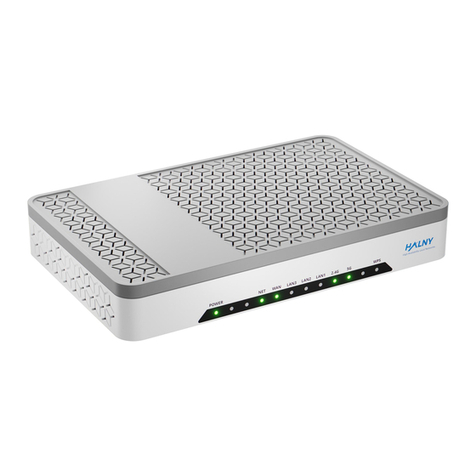
HALNy
HALNy HLE-3GX-F Quick installation guide
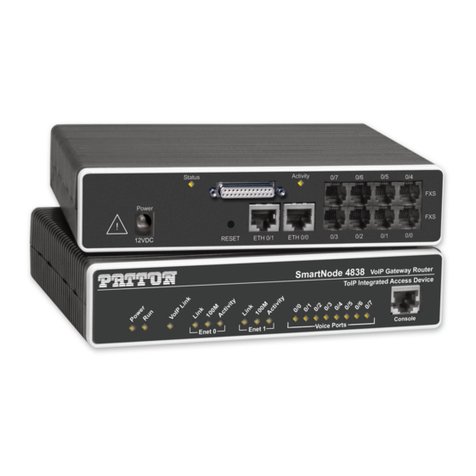
Patton electronics
Patton electronics SmartNode 4830 Series quick start guide
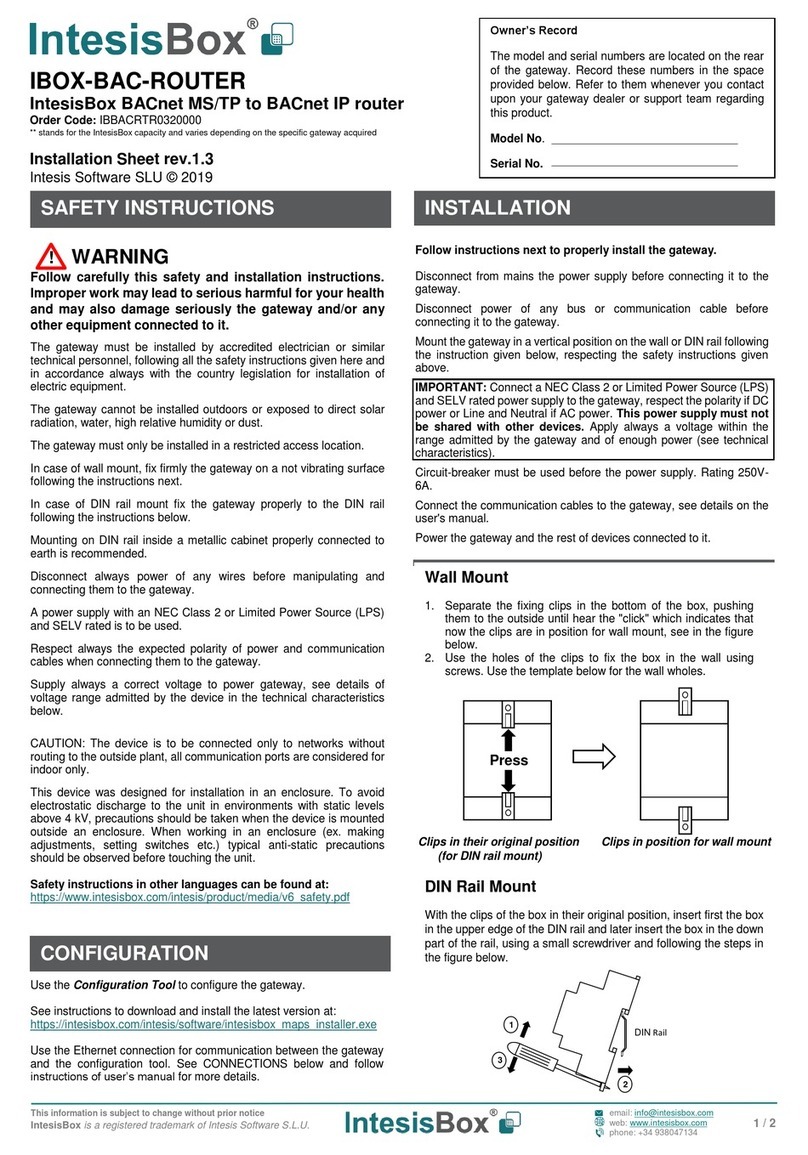
IntesisBox
IntesisBox IBOX-BAC Series Installation sheet
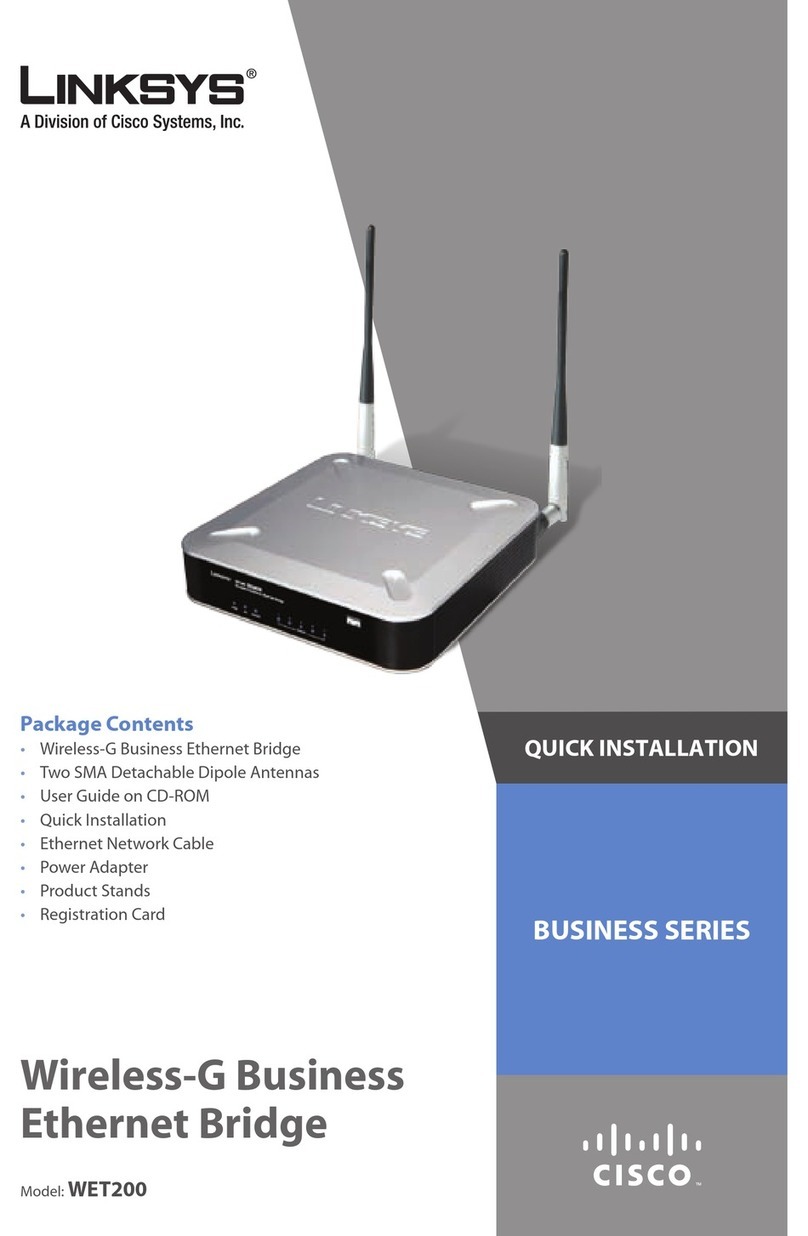
Linksys
Linksys WET200 - Wireless-G Business Ethernet Bridge Quick installation

AllisCom
AllisCom MG700 user manual
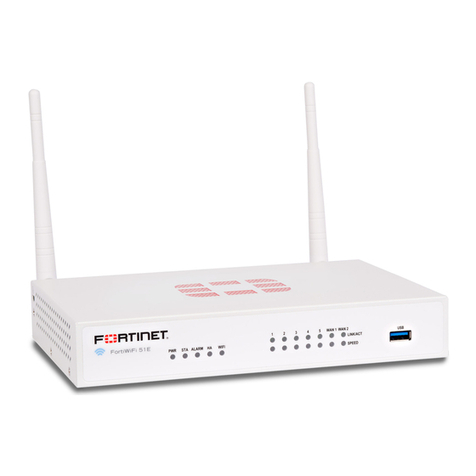
Fortinet
Fortinet FortiGate 30E Information
